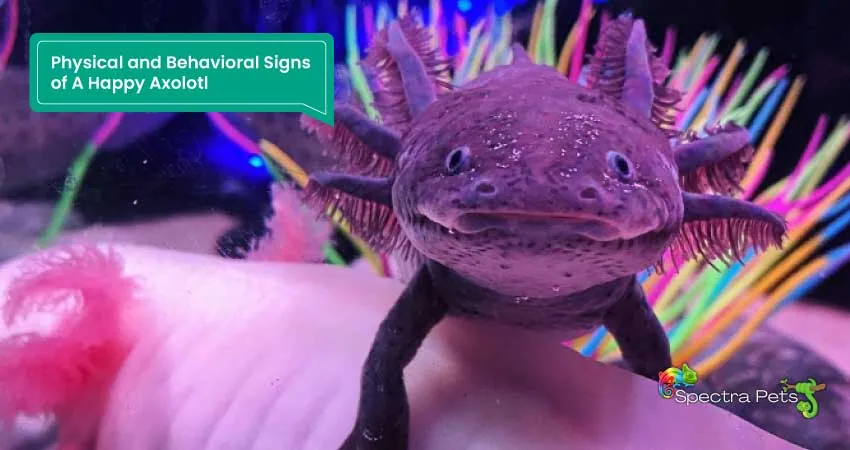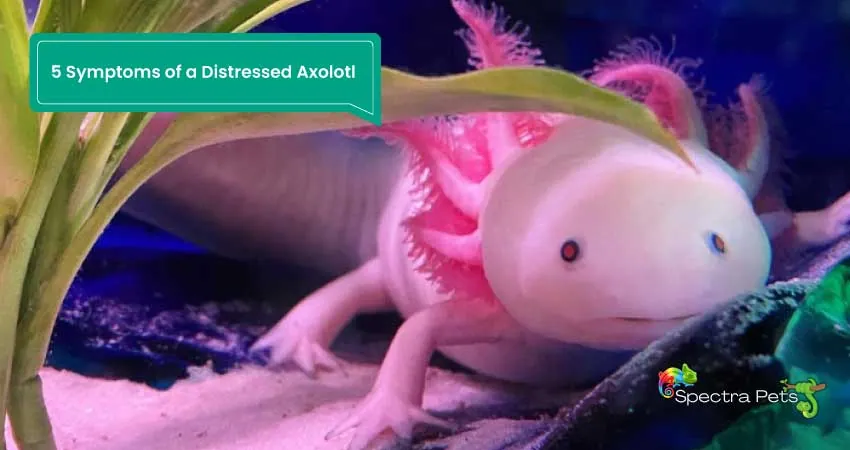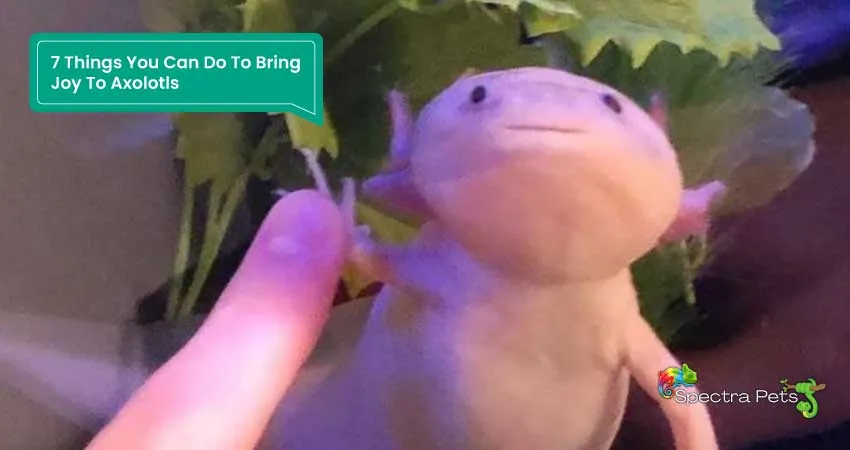Diving into the captivating world of aquatic pets, the axolotl stands out as a unique and enigmatic creature. This salamander species is easygoing, low-maintenance, and loved by pet owners around the world.
But as caretakers, how can we determine if our axolotls are truly content in their underwater realm? Well, it’s a whole different ballgame. While axolotls have these cute smiles on their faces, you can’t rely solely on their physical appearance to determine their happiness. It all comes down to their behavior and how comfortable they are with their surroundings.
If your little amphibian friend is eating well, acting lively, and looking good, chances are they’re feeling pretty darn happy. But you need to pay attention if you notice any hints of sluggishness, paleness, or loss of appetite.
Curious to learn more about the telltale signs that reveal your axolotl’s happiness? Let’s go deeper into this topic together.
Physical and Behavioral Signs of A Happy Axolotl
While axolotls may not possess the same emotional spectrum as humans, they exhibit behaviors that signal their comfort and well-being. Also, you can tell whether they are happy or not by inspecting their physical condition.

Now, first, we will see the behavioral signs of a happy axolotl. Let’s begin…
Behavioral Signs of a Happy Axolotl:
Here are some key behavioral signs to look out for to determine if your axolotl is happy:
1. Active and Engaged
A happy axolotl will exhibit increased activity levels, swimming around its tank with purpose and curiosity. It will explore its surroundings, interact with objects, and show interest in its environment. Moreover, a content axolotl may display playful behaviors such as chasing after food, swimming through obstacles, or interacting with tank mates in a gentle and non-aggressive manner.
In addition to being playful, a happy axolotl will show curiosity by actively investigating plants and decorations. It may explore new additions to its environment, inspecting and dancing around them.
2. Responsive to Owner
Your happy axolotl may recognize you and respond positively when approached. It may swim towards the tank’s glass, showing recognition and excitement. Your cute friend may also interact with you during feeding time, displaying eagerness and anticipation.
Moreover, it may also try to mimic your movements, such as waving its fins, and may even follow you around the tank. Additionally, the axolotl may also recognize its own name and respond accordingly.
3. Peaceful Interactions with Tank Mates
If housed with compatible tank mates, a happy Axolotl will engage in peaceful interactions. It may swim alongside its companions, display social behaviors such as nudging, or engage in courtship rituals. It is important to ensure that tank mates are of similar size, to avoid aggression or injury.
Additionally, tank mates should be chosen carefully, as Axolotls are known to eat smaller tank mates or even their own babies. Finally, tanks should be large enough to provide enough space for all inhabitants to swim comfortably.
4. Voracious Appetite
A healthy axolotl will have a hearty appetite. If your axolotl eagerly devours its food during feeding time, it is a positive indication that it is content and thriving. Pay attention to its feeding habits and ensure it receives a balanced diet.
5. Minimal Hiding and Leisurely Floating
Axolotls are naturally nocturnal creatures and may seek shelter during the day. However, a happy axolotl will exhibit minimal hiding behavior. It will confidently explore its tank during daylight hours, indicating a sense of security and comfort. If your axolotl is consistently hiding, it may be a sign of stress or an inadequate tank setup.
Physical Signs of a Happy Axolotl
Now let’s figure out the physical signs:
1. Vibrant Coloration
A happy axolotl will display vibrant and well-defined coloration, reflecting its overall good health and contentment. The skin pigmentation should be bright and consistent without any signs of discoloration or fading.
Also, a content axolotl will have smooth and healthy skin. It should appear intact, free from lesions, scratches, or signs of injury. Overall, a healthy skin condition is a positive indication of a happy axolotl.
2. Healthy Eyes and Gills
A healthy and happy Axolotl’s eyes would be clear, bright, and free from cloudiness or discharge. Also, having open and relaxed gills during respiration with no signs of inflammation, or discoloration indicates that your Axolotl is physically happy.
3. Strong and Intact Limbs
A happy axolotl will have strong and intact limbs, including its front and back legs. The limbs should not show any signs of injury, swelling, or difficulty in movement.
4. Adequate Body Size and Weight
Your axolotl will maintain a healthy body size and weight according to its age and genetics when its happy. It should have a well-rounded body shape without being overly thin or obese.
Remember that assessing the happiness of an axolotl requires considering both behavioral and physical signs together. By observing these indicators, you can ensure that your axolotl is in a state of well-being and provide appropriate care to maintain its happiness and overall health.
5 Symptoms of a Distressed Axolotl

If your axolotl appears to be suffering from distress, consider these common symptoms.
1. Loss of Appetite
If your axolotl is experiencing a loss of appetite, it could be a sign of illness or distress. When your axolotl is unwell, it is common for them to avoid their food. This diminished interest in eating is usually the first indication of a problem and should serve as a warning that further symptoms may manifest in your axolotl’s behavior.
2. Gills Curled Up
When the gills of your axolotl are curled up, it could indicate sickness or the onset of a fever. Certain illnesses pose a severe threat to axolotls and, if left untreated, may result in fatality. It is crucial to provide prompt medical attention to ensure the well-being and survival of your axolotl.
To aid in the healing process of axolotls, various home remedies can be employed. Black tea baths, warm water baths, and treated water baths have shown the potential in promoting recovery. Additionally, salt baths have been known to be beneficial for curing axolotls.
3. Excessive Hiding
When an axolotl is unwell, it tends to hide continuously, making it challenging to locate them. Consistent hiding behavior can indicate physical or mental issues in your axolotl.
4. Emerging from Water
If your axolotl frequently sticks its back or tail out of the water, it could be a sign of distress. In certain cases, an ailing axolotl or one lacking adequate hiding spaces may stay near the surface of the tank.
5. Frequent Active Swimming
It is normal for an axolotl to engage in occasional bursts of energetic swimming within its tank, especially when frightened. These lively movements often occur in response to external or internal stimuli that scare the axolotl. Instances such as loud noises or strong vibrations can potentially cause distress to your axolotl.
So, keeping loud noises and vibrations to a minimum will make your axolotl feel more comfortable and prevent excessive swimming.
Read Also: Axolotls Defense Mechanism
7 Things You Can Do To Bring Joy To Axolotls

There are various measures you can undertake to ensure the happiness of your beloved Axolotls. Here are they:
1. Providing a Serene Habitat
To guarantee the comfort and serenity of Axolotls, it is imperative to create an environment tailored to their specific needs. This entails maintaining an optimal temperature, ensuring pristine water quality, and offering ample space.
Moreover, these fascinating creatures must have proper water conditions, an effective filtration system, and hiding places in order to remain happy and healthy.
2. Diverse and Nourishing Diet
Axolotls must have a nutrient-rich, well-rounded diet in order to thrive happily. Incorporating live or frozen foods into their meals is essential.
It might be a good idea to feed them brine shrimp, bloodworms, small fish, or other aquatic creatures. Remember, adequate protein and nutrient intake is vital to keep Axolotls content and elated.
3. Regular Tank Maintenance
Diligently attending to tank maintenance, including water changes and filter cleaning, is of utmost importance when caring for Axolotls. By doing so, you can avert the accumulation of harmful chemicals and bacteria that may endanger their health.
4. Enrichment Activities
Axolotls possess an innate curiosity, and engaging them with stimulating activities can greatly contribute to their happiness. Encourage exploration by introducing new plants and decorations. Additionally, providing them with food puzzles or toys can enhance their well-being.
5. Ensuring Optimal Health
Axolotls thrive when they don’t have illnesses or injuries. By providing appropriate care and scheduling regular check-ups with a veterinarian, you can improve their quality of life to make them more content.
6. Mimicking Natural Lighting
Consider replicating the natural lighting conditions that Axolotls experience in the wild. Employing suitable lighting and maintaining a consistent brightness schedule enables Axolotls to maintain a balanced sleep-wake cycle. Furthermore, it enhances their activity levels, relieves stress, and helps them behave naturally.
7. Suitable Tank Mates
Introducing compatible tank mates of similar temperament and size to your Axolotls can help minimize aggression and reduce stress. Apart from other Axolotls, shrimp, snails, and certain fish can coexist peacefully. Creating a natural and stimulating environment by keeping them together can further enhance the well-being of your Axolotls.
Frequently Asked Questions
How does an unhappy axolotl look?
An unhappy axolotl can exhibit curled gills, which is one of the primary and frequently observed signs of stress. If you notice your axolotl’s gills curving outward, toward the front, it may indicate unhappiness or discomfort.
Can Axolotls Experience Depression?
Generally, axolotls are resilient creatures and do not exhibit signs of depression. Even though axolotls don’t get depressed, they do show signs of distress in some situations.
Final words
Axolotls may not express emotions like humans or other mammals, but they do exhibit signs that indicate their well-being and contentment. To ensure your pet Axolotl is happy and thriving, it’s essential to provide it with suitable habitat, a balanced diet, and regular monitoring for any signs of stress.
Always prioritize the health and happiness of your Axolotl, and consult a professional veterinarian if needed.
